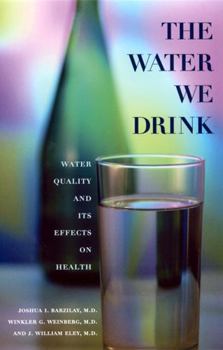The Water We Drink: Water Quality and Its Effects on Health
Select Format
Select Condition 
Book Overview
We all drink water and water-based fluids, yet most of us take water for granted. We assume that when we turn on the tap to fill our glass, bathtub, or washing machine, clean water will flow. But is it really safe? And if it is not, what can we do about it? The doctors who have written The Water We Drink provide readers with practical information on the health issues relating to water quality and suggest ways we can improve the quality and...
Format:Paperback
Language:English
ISBN:0813526736
ISBN13:9780813526737
Release Date:May 1999
Publisher:Rutgers University Press
Length:192 Pages
Weight:0.60 lbs.
Dimensions:0.6" x 5.5" x 8.5"
Customer Reviews
3 ratings
Is Bottled Safe Now?
Published by Thriftbooks.com User , 15 years ago
Americans are drinking more than twice the bottled water we did a decade ago. Bottled water now is everywhere. Evian water bottle was popular as a fashion accessory in the '80s fashion scene in Los Angeles. From the corporate boardrooms of New York City to the campgrounds of Yosemite National Park, Americans are drinking bottled was as never before. In fifteen years (1984 to 1999), consumption in the U. S. tripled. In 2001, Aquafina, purified tap water of Wichita, Kansas, was the top selling brand replacing that from Atlanta, GA, bottled by Coca Cola, Dasani. The back lash in 2007 of the tap water aspect led to Poland Spring of Maine to become the top seller. In 1820 was the beginning of bottling for resale the spring water at Saratoga Springs, New York, and used as a cure for stomach ailments, called "Doctor Clark." Twenty years later, Poland Spring in Maine started the most advantageous and successful American bottling (the #1 today) of water as a cure for kidney ailments. Napoleon III decreed that Perrier water was to be bottled for the good of France in 1863. Italians drink the most at fifty galloons a year. In 1912, the water fountain for use in public buildings was invented by Hal Taylor. All this bottling and packaging goes back to King Cyrus the Great of Persia whose brilliance led to boiling drinking water to be carted in silver flagons to war. Da Vinci, in 1509, declared San Pellegrino water miraculous. The brother of Andrew Wyeth invented plastic bottles in 1968. Perrier water was packaged in green glass. In 1976, the average American drank 1-6 gallons a year; by 2006 we drank a shopping 28.3 galloons. Noncarbonated bottled water is the fastest grtowing segment of the U. S. beverage industry. Recent annual sales have reached 3.5 billion dollars. Water is the perfect drink, healthyu, refreshing and satisfying in a way Cokes, 7Ups, juices or alcohol aren't. In the U. S. many of the earliest brands were associated with resorts and spa complexes. The mystique of today's normal thing to do (no longer a status symbol) was started in 1928 . Mythology that mineral water improves one's overall health is questionable. I can't stomach tge taste if nminerak water; just because we think it's healthy doesn't make it so. TVA uses so many chem,icals in the dams up and dow \n the Tennessee River. At first in 1976, water was delivered in large bottles to homes and offices and at grocery stores in galloon jugs. It's more economical to purchase the heavy jugs, the mainstream water businesss is a force of nature. Compare bottled to tap water: now, the secret is out and we know it is safe only so far. Any water source can be tampered with to make it unsafe, like any food or medicine at any grocery store. Thanks to Al Gore and his vigilance about global warming, drinking water is under environmental scrunity like never before. Water, pure, healthy, perfect...until now. Toxins can be added anywhere along the way. There's not
Required reading for many different professions and people
Published by Thriftbooks.com User , 24 years ago
So many people can benefit from this book: nutritionists, nurses, physical therapists, sports medicine, environmental sciences, etc. I only wish the media would present such informatiion as clearly to the public as this book does.
This book is a readable summary of a technical issue.
Published by Thriftbooks.com User , 24 years ago
The authors of this book have taken what is surely a very complex issue and made it both readable and informative. They cover all or most of the issues concerning both tap and bottled water and allow the reader to make up his or her mind about which course to follow. I particularly appreciated the history of drinking water going back to Biblical and Talmudic times. I think anyone who drinks water would benefit from this book.





